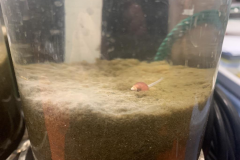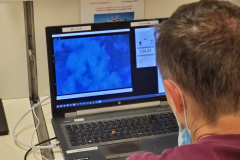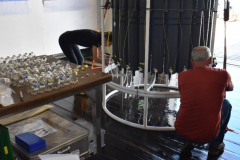
The Benguela System under climate change - Effects of Variability in physical forcing on carbon and oxygen budgets
15.01.2022 Tracking the microbial communities
Finally, the time has come. We have discovered our first oxygen-free zones and sampled them a little more intensively. Using a pumpCTD, we can determine the distribution of various parameters in the water column with high resolution. The pumpCTD is a modification of the CTD. By additionally attaching a pump-tube system, seawater can be transported from defined depths to the surface. Coupled with various sensors for measuring oxygen, hydrogen sulphide, the climate-relevant gases methane and nitrous oxide, as well as a device for the automatic quantification of various nutrients such as nitrate, nitrite, ammonium and phosphate, we can generate high-resolution profiles in the metre range of the water column.
In addition to macrozoobenthologists, the microbiologists among us also want to understand how different organisms, in this case bacteria and archaea, change their metabolism under oxygen deprivation. In the Benguela upwelling system, microorganisms have a key function in various biogeochemical processes, such as the formation of the trace gases nitrous oxide and methane, and the oxidation of hydrogen sulphide. In order to gain a better insight into the functions of microorganisms, the Geomicrobiology group, led by Prof. Dr. Heide Schulz-Vogt, and the Microbial Ecology group, led by Prof. Dr. Klaus Jürgens, are investigating the composition and activity of the microbial community in the oxygen-poor or oxygen-free layers of the water column. Another focus is on seasonal differences in the bacterial communities. For this purpose, stations that were already visited during the winter cruise M157 with the FS "Meteor" in 2019 will be sampled again. A distinction will be made between free-living and particle-bound bacteria, which will be separated from each other by size fractionation. To investigate functional genes and to record the entire bacterial gene pool, water samples are fixed in situ directly during sampling using modified water samplers on the CTD, the so-called AFIS (Automatic Flow Injection Sampler) system.
In addition, PhD student Gabriela Dangl is conducting experiments on board with water from stations with high nitrous oxide concentrations. The aim is to find out which microbial processes contribute to nitrous oxide production in the Benguela upwelling area and whether these change with environmental factors, such as oxygen availability or the occurrence of hydrogen sulphide. These results will later be merged with those of the measurements made by the Trace Gas Working Group, whose work we will explain in more detail in an upcoming post.
Another highlight today was that we were able to detect the first mats of large sulphur bacteria on the seafloor via the camera attached to the PumpCTD. These mats consisted mainly of sulphur bacteria of the genera Beggiatoa and Thiomargarita.
Text: Fabian J., Braun P. (both IOW)
| Expedition: | MSM105 |
| Mission: | BUSUC 2 |
| Start: | 11.01.2022 - Walvis Bay |
| Ziel: | 23.03.2022 - Mindelo |


